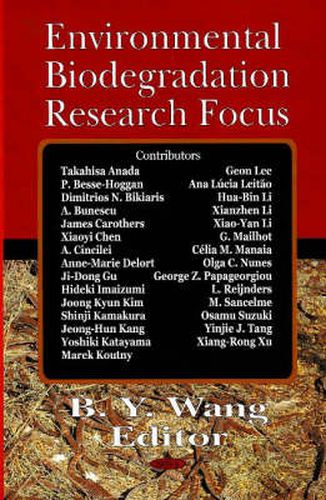Readings Newsletter
Become a Readings Member to make your shopping experience even easier.
Sign in or sign up for free!
You’re not far away from qualifying for FREE standard shipping within Australia
You’ve qualified for FREE standard shipping within Australia
The cart is loading…






This new book is devoted to leading-edge research on environmental biodegradation which is the destruction of organic compounds by microorganisms. Microorganisms, particularly bacteria, are responsible for the decomposition of both natural and synthetic organic compounds in nature. Mineralisation results in complete conversion of a compound to its inorganic mineral constituents (for example, carbon dioxide from carbon, sulphate or sulphide from organic sulphur, nitrate or ammonium from organic nitrogen, phosphate from organophosphates, or chloride from organochlorine). Since carbon comprises the greatest mass of organic compounds, mineralisation can be considered in terms of CO2 evolution. Radioactive carbon-14 (14C) isotopes enable scientists to distinguish between mineralisation arising from contaminants and soil organic matter. However, mineralisation of any compound is never 100% because some of it (10-40% of the total amount degraded) is incorporated into the cell mass or products that become part of the amorphous soil organic matter, commonly referred to as humus. Thus, biodegradation comprises mineralisation and conversion to innocuous products, namely biomass and humus. Primary biodegradation is more limited in scope and refers to the disappearance of the compound as a result of its biotransformation to another product. Compounds that are readily biodegradable are generally utilised as growth substrates by single microorganisms. Many of the components of petroleum products (and frequent ground-water contaminants), such as benzene, toluene, ethylbenzene, and xylene, are utilised by many genera of bacteria as sole carbon sources for growth and energy.
$9.00 standard shipping within Australia
FREE standard shipping within Australia for orders over $100.00
Express & International shipping calculated at checkout
This new book is devoted to leading-edge research on environmental biodegradation which is the destruction of organic compounds by microorganisms. Microorganisms, particularly bacteria, are responsible for the decomposition of both natural and synthetic organic compounds in nature. Mineralisation results in complete conversion of a compound to its inorganic mineral constituents (for example, carbon dioxide from carbon, sulphate or sulphide from organic sulphur, nitrate or ammonium from organic nitrogen, phosphate from organophosphates, or chloride from organochlorine). Since carbon comprises the greatest mass of organic compounds, mineralisation can be considered in terms of CO2 evolution. Radioactive carbon-14 (14C) isotopes enable scientists to distinguish between mineralisation arising from contaminants and soil organic matter. However, mineralisation of any compound is never 100% because some of it (10-40% of the total amount degraded) is incorporated into the cell mass or products that become part of the amorphous soil organic matter, commonly referred to as humus. Thus, biodegradation comprises mineralisation and conversion to innocuous products, namely biomass and humus. Primary biodegradation is more limited in scope and refers to the disappearance of the compound as a result of its biotransformation to another product. Compounds that are readily biodegradable are generally utilised as growth substrates by single microorganisms. Many of the components of petroleum products (and frequent ground-water contaminants), such as benzene, toluene, ethylbenzene, and xylene, are utilised by many genera of bacteria as sole carbon sources for growth and energy.